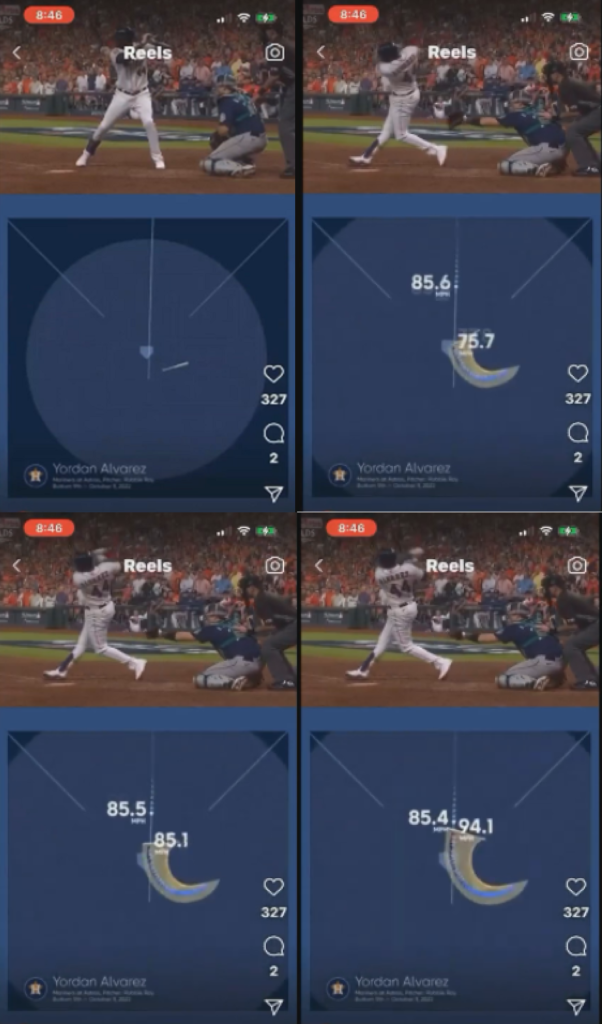The Myth of the Pendulum: Insights into Barrel Acceleration in Baseball Swings
By Ken Cherryhomes
Barrel Acceleration: In this series of frames, we can observe the acceleration of Yordan Alveraz’s swing along three common points of contact: Outside, middle, and inside. To qualitatively assess the rate of barrel acceleration, we must first establish a fixed point from which to measure from. That point is the front edge of home plate, in this scenario.
The first collision point is the outside point of contact for this swing’s arc, which is approximately 8-1/2” behind the front edge of the plate. The barrel’s final velocity at this point of impact was 75.7mph.
From there, the barrel arcs to the middle position, where the barrel is parallel or equal to the batter’s hands, directly above the front edge of home plate. Here the barrel’s final velocity was measured at 85.1mph, an increase of 9.4mph over 8-1/2”.
Finally, we arrive at the point of contact which is 12” in front of the front edge of home plate, where the final barrel velocity was measured at 94.1mph, an increase of 9mph over a distance of 12”.
Contrary to the common beliefs among many baseball experts that maximum barrel velocity is achieved at the point where the bat’s arc levels with the hands, the barrel’s sweet spot directed toward centerfield—akin to the apex of a pendulum’s swing—data from this swing shows the barrel continues to accelerate even after passing this point. This suggests that the rate of acceleration, while diminishing, does not halt or reverse immediately. The barrel velocity increases beyond the parallel point, indicating that the bat’s swing dynamics allow for continued acceleration beyond the hands, challenging the conventional understanding of when peak velocity occurs in a baseball swing.
Empirical evidence from baseball statistics aligns with this assertion in that the hardest-hit balls and the longest home runs are pulled ones. Now, thanks to the Hawkeye system, we have more data to support this.
Deceleration Misconception: The common misconception is that once the bat is no longer being actively accelerated (when it’s equal to the hands), it must be decelerating due to gravity and air resistance. However, what’s crucial to understand is that deceleration isn’t immediate. The bat, having mass and momentum, will continue to travel forward at an almost constant speed for a brief moment, even potentially accelerating slightly if the batter is still applying force, albeit less effectively.

When the bat passes the hands, the direction of force changes. Instead of the hands pulling the bat forward, they start to resist the forward motion of the bat.
As the barrel of the bat moves forward, its mass wants to continue moving straight (Newton’s first law), towards the pitcher in this case. The batter’s hands provide the centripetal force necessary to redirect the bat into a circular path. When the bat’s barrel is in front of the hands, the hands are no longer pulling it forward. The momentum of the bat wants to carry it forward, but because the hands are now pulling in a different direction, the bat’s path curves. This is where the rotational dynamics and the axis of rotation become important.
Even though the bat is being pulled back towards the body and the axis of rotation, its path is the result of both the forward momentum and the centripetal force applied by the hands. The bat is essentially being swung around the body at this point, and while the hands are pulling back, the bat itself is still moving forward relative to the field of play.
The energy transfer to the bat isn’t ceasing; rather, the nature of the force application is changing. Early in the swing, the batter is applying force mostly in the form of torque to accelerate the bat. As the bat comes around and the barrel moves in front of the hands, the batter’s role shifts to guiding and controlling the bat to ensure that it meets the ball squarely while maintaining as much of the built-up momentum as possible.
So, in essence, while the bat is being pulled back towards the axis of rotation, this does not immediately decelerate the bat; the forward momentum and the energy transferred earlier in the swing are still propelling the bat forward, contributing to the speed at impact.
Please send questions and comments to:
